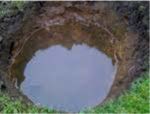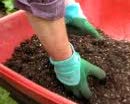Improving Clay Soils
Simple Practices for Planting in clay soils
AT A GLANCE
- Raise plantings above surrounding soil
- Add lots of organic matter such as compost
- Add Gypsum or Lime
Why are Clay Soils a Problem?
Put simply, plants fail to thrive in clay soil for two main reasons:
1. Poor Drainage
Plants get water logged in winter and eventually die from root rot.
Whilst the rotting occurs in winter, in some cases plants survive until the stress of summer before they die.
2. Clay Structure 
Clay soil particles are so fine and tightly packed it is difficult for plants to extract nutrients and water.
To improve clay soils, so that plants will thrive, it is necessary to ensure that these plants don’t become water logged.
Therefore you need to modify the soil so it is open, aerated and easily worked.
How to Improve Clay Soils 
Raise Planted Areas
This is the most effective way of improving drainage in a clay soil.
Build the soil level up by adding compost or planting mix. In extreme cases some additional top soil may be required.
This provides a good depth of soil above the heavy clay zone in which plants can grow.
Do not dig holes down into the solid clay sub-soil and plant down to this level. It is holes like this that hold water like a bucket and plants drown.
Add Organic Matter (e.g. compost, planting mix)
By adding organic matter, in the form of compost, and mixing it with the fine clay soil particles, the result is a soil which is more open and aerated.
It is more fibrous and spongy in texture and plant roots can penetrate.
It is easier to cultivate and weed.
It also drains more readily so that plants can quickly and easily extract the water and nutrients they need.
Add Gypsum
Gypsum is pH neutral, so is safe to use at planting time. It causes a chemical and physical change, which results in the fine clay particles forming clusters or large particles.
This in turn creates larger air spaces in the soil which improves aeration and drainage, leading to improved root penetration.
AFTER CARE
Over time, the added compost will break down and the improvement effect is lost. 
This can be avoided by adding a layer of compost or mulch to the soil each year.
Around permanent plantings of trees and shrubs add a layer of mulch such as pea straw, granulated bark or compost.
For cultivated vegetables or flower gardens, add compost or planting mix and work this in before planting each spring.
6490